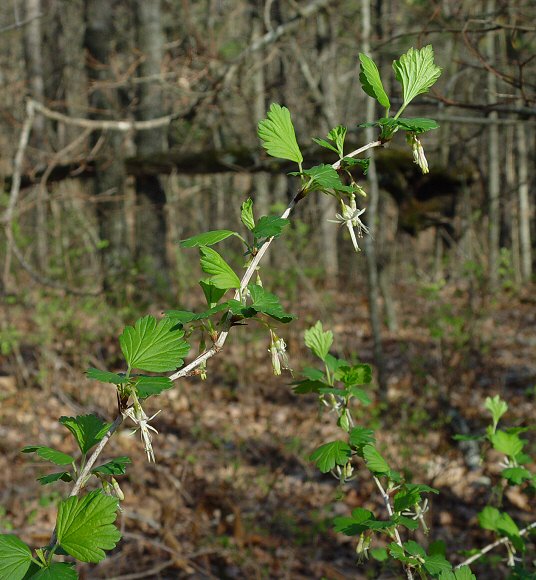Ribes missouriense Nutt.
Missouri Gooseberry

Native
CC = 3
CW = 5
MOC = 78
© DETenaglia
Ribes missouriense Nutt.Missouri Gooseberry | |
 |
Native CC = 3 CW = 5 MOC = 78 |
© DETenaglia |
|
Family - Grossulariaceae Habit - Shrub. Stem - Spreading or arching, to 2 m, sometimes armed with stiff internodal bristles (slender prickles), more commonly with slender straight to slightly curved nodal spines, these 7-18 mm long, reddish brown. Bark smooth or somewhat scaly, peeling or shredding in narrow papery strips, dark gray to reddish brown.
Leaves - Alternate, often appearing fascicled, simple, petiolate. Petioles 0.6-2.0 cm long, often with dense nonglandular hairs. Leaf blades 0.5-3.0 cm long, broadly obovate to broadly ovate in outline, broadly narrowed to rounded or sometimes subcordate at the base, 3- or 5-lobed, the lobes mostly rounded to bluntly pointed at the tip, the margins toothed, the upper surface sparsely to moderately minutely nonglandular-hairy, becoming glabrous or nearly so and somewhat shiny with age, the undersurface sparsely and minutely nonglandular-hairy, especially along the veins, becoming glabrous or nearly so with age.
Inflorescence - Small axillary clusters or racemes of pendent flowers, sometimes appearing umbellate, the stalks 4-13 mm long, with a minute glandular or herbaceous bract toward the midpoint.
Flowers - Perfect, actinomorphic, epigynous. Hypanthium cylindrical, the tubular portion above the ovary 1.5-2.5 mm long, greenish white to cream-colored, glabrous or sometimes with sparse minute nonglandular hairs. Sepals 5, 5-8 mm long, longer than the hypanthium tube. Petals 5, 2.0-3.5 mm long, white or sometimes tinged with pink, shorter than the sepals and often shorter than the stamens. Stamens 5, long-exserted, alternating with the petals, attached to the hypanthium. Pistil 1 per flower, of 2 fused carpels. Ovary inferior, not grooved, glabrous, with 1 locule, with few to many ovules, the placentation parietal. Style 1, sometimes 2-lobed, elongating during flowering.
Fruits - Berries 6-12 mm long, globose, glabrous, without prickles, green and translucent when young, becoming red to purple at maturity.
Flowering - April - May. Habitat - Forests, streambanks, roadsides, previously grazed or clear-cut areas. Origin - Native to the U.S. Lookalikes - R. cynosbati, also Physocarpus opulifolius when not flowering. Other info. - This is by far the most common wild gooseberry in Missouri, occurring across most of the state except for the Bootheel region. Its range within North America is a well-defined patch in the Midwest, mostly confined to about 7 states centered at about the Missouri - Iowa border. Photographs taken in the Piney Creek Wilderness, MO., 4-4-04 (DETenaglia), also at Weldon Spring Conservation Area, St. Charles County, MO, 05-18-2008, Little Lost Creek Conservation Area, Warren County, MO, 04-23-2014, and Young Conservation Area, Jefferson County, MO, 04-18-2015 (SRTurner). |